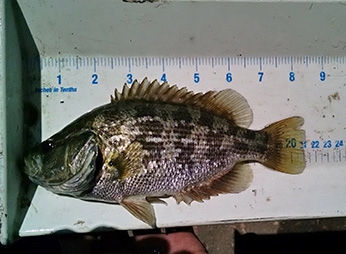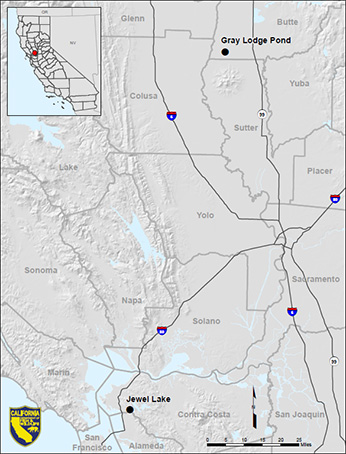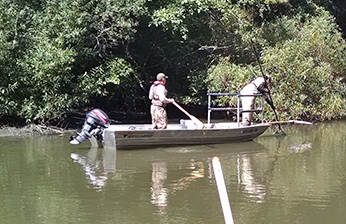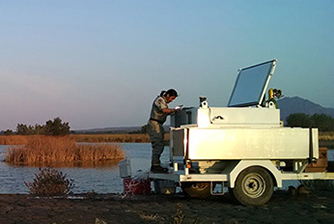July 2015 Update

 (click/tap to enlarge)
(click/tap to enlarge)
In March 2015, CDFW staff returned to the Gray Lodge pond to assess the status of the fish rescued from Jewel Lake just seven months earlier. The staff conducted a boat based electrofishing survey and found 665 juvenile Sacramento Perch, indicating the original fish were able to reproduce. So far the fish have responded well and have produced several different cohorts. An additional survey will be conducted in the fall of 2015 to monitor recruitment through the rest of the spring and summer.
Species Distribution and Lack of Genetic Diversity
Sacramento Perch Archoplites interruptus belong to the family Centrarchidae, and were native to the Central Valley, Salinas and Pajaro rivers, and Clear Lake (Lake County) where they inhabited mostly sloughs, slow moving streams and lakes. Early accounts described their abundance and potential as food fish, and were commonly caught by native peoples (Moyle 2002). A combination of factors, including the restructuring of the Sacramento-San Joaquin Delta, competition with non-native Centrarchids (sunfish) and direct predation has caused extirpation from their native range and listing as a California Department of Fish and Wildlife (CDFW) Species of Special Concern. One major concern for Sacramento Perch is the lack of genetic diversity within remaining populations which may limit long term adaptability to changes in the environment.
Necessity of Rescue
In 2008, biologists identified a small population of genetically distinct Sacramento Perch in Jewel Lake, located in Tilden Park, Contra Costa County (Schwartz and May 2008). Over the years, the accumulation of silt resulted in diminished habitat quality for the fish and compounded by drought, lake conditions reached a point in 2014 where survival of the fish was uncertain. Since red legged frog, a species federally listed as threatened were observed in the vicinity, removing silt to restore lake depth was not an option. CDFW and East Bay Regional Parks District (EBRPD) were motivated to formulate rescue plans to save this genetically distinct population.
Relocation Site
Coincidentally, the Gray Lodge Wildlife Area (Gray Lodge) in Butte County constructed a 4.5 acre pond in anticipation of raising Sacramento Perch to help with mosquito control. Although not intended for Jewel Lake fish, the availability of the pond was fortuitous and the screening and filling occurred just in time to receive the genetically distinct rescued fish.
Rescue Methods
On August 7, 2014, 70 Sacramento Perch were collected via boat-based electrofishing only (Figure 1). On August 8, 2014, 121 Sacramento Perch were collected via boat-based electrofishing, traps and nets. Collected fish were transferred to a 400 gallon transport trailer and driven about 135 miles north to Gray Lodge (Figure 2). Water temperature in the new pond was warmer than Jewel Lake, so fish needed to be slowly acclimated before being released.
 Figure 1
Figure 1
 Figure 2.
Figure 2.
Fish Survival
The two day rescue effort resulted in the transfer of 178 Jewel Lake Sacramento Perch to Gray Lodge. Thirteen fish died during transport from any combination of stresses associated with handling and moving fish. To date, the fish are doing well adapting to their new environment.
Future Jewel Lake
EBRPD is having ongoing discussions regarding strategies to mitigate sediment accumulation in Jewel Lake. Without some intervention to minimize sediment accumulation Jewel Lake will likely progress into a meadow.
Data
Jewel Lake Sacramento Perch Data
| Date |
# Collected |
# Mortalities |
# Relocated |
| August 7, 2014 |
70 |
8 |
62 |
| August 8, 2014 |
121 |
5 |
116 |
| Total |
191 |
13 |
178 |
Project Permitting
Interagency Fish Rescue Policy (CDFW/NMFS/USFWS). Fish rescue by CDFW is exempt under CEQA.
Partner
- California Department of Fish and Wildlife and East Bay Regional Parks District
References
- Moyle, P.B. 2002. Inland Fishes of California, University of California Press.
- Schwartz, R. S. and B. May. 2008. Genetic Evaluation of Isolated Populations for use in Reintroductions Reveals Significant Genetic Bottlenecks in Potential Stocks of Sacramento Perch. Transactions of the American Fisheries Society 137:1764-1777
CDFW
CDFW Fisheries Branch
830 S Street
Sacramento, CA 95811
(916)-327-8840
East Bay Regional Park District
Acting Fisheries Program Manager
(510)-544-2329